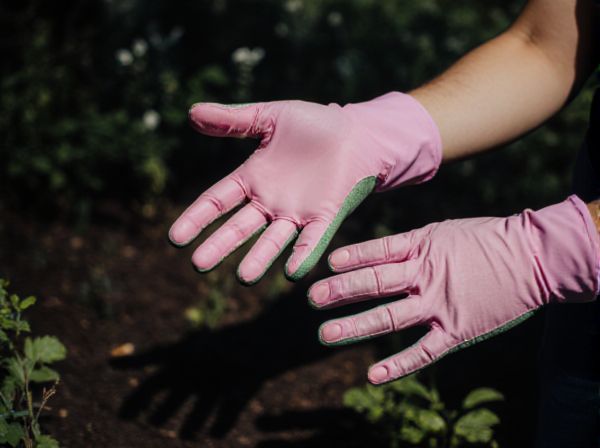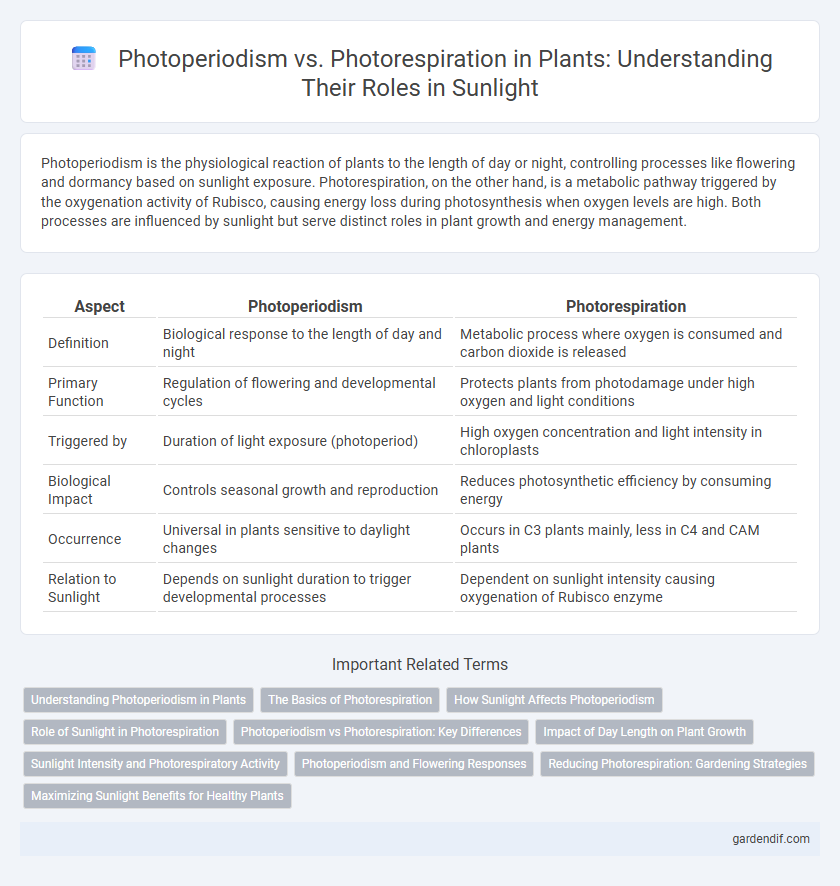
Photoperiodism vs Photorespiration Illustration
Photoperiodism is the physiological reaction of plants to the length of day or night, controlling processes like flowering and dormancy based on sunlight exposure. Photorespiration, on the other hand, is a metabolic pathway triggered by the oxygenation activity of Rubisco, causing energy loss during photosynthesis when oxygen levels are high. Both processes are influenced by sunlight but serve distinct roles in plant growth and energy management.
Table of Comparison
| Aspect | Photoperiodism | Photorespiration |
|---|---|---|
| Definition | Biological response to the length of day and night | Metabolic process where oxygen is consumed and carbon dioxide is released |
| Primary Function | Regulation of flowering and developmental cycles | Protects plants from photodamage under high oxygen and light conditions |
| Triggered by | Duration of light exposure (photoperiod) | High oxygen concentration and light intensity in chloroplasts |
| Biological Impact | Controls seasonal growth and reproduction | Reduces photosynthetic efficiency by consuming energy |
| Occurrence | Universal in plants sensitive to daylight changes | Occurs in C3 plants mainly, less in C4 and CAM plants |
| Relation to Sunlight | Depends on sunlight duration to trigger developmental processes | Dependent on sunlight intensity causing oxygenation of Rubisco enzyme |
Understanding Photoperiodism in Plants
Photoperiodism in plants is the physiological reaction to the length of day and night, which regulates key developmental processes like flowering and dormancy. This adaptation allows plants to synchronize their life cycles with seasonal changes, optimizing growth and reproduction under varying sunlight conditions. Unlike photorespiration, which involves energy loss during photosynthesis, photoperiodism directly influences gene expression and hormonal changes that determine plant behavior in response to photoperiod length.
The Basics of Photorespiration
Photorespiration is a metabolic pathway in plants where oxygen competes with carbon dioxide for the active site of the enzyme RuBisCO, leading to the consumption of energy and release of CO2 without producing sugars. Unlike photoperiodism, which regulates plant development based on daylight duration, photorespiration directly impacts photosynthetic efficiency by reducing carbon fixation under high oxygen and light conditions. Understanding the basics of photorespiration is crucial for improving crop productivity in environments with intense sunlight and varying oxygen levels.
How Sunlight Affects Photoperiodism
Sunlight intensity and duration are critical factors influencing photoperiodism, the biological response of plants to the length of day and night, regulating flowering and other developmental processes. Photoreceptors such as phytochromes detect changes in sunlight, triggering gene expression that controls seasonal growth cycles. Unlike photorespiration, which is a metabolic process linked to photosynthesis efficiency, photoperiodism specifically relies on sunlight duration to synchronize plant behavior with environmental conditions.
Role of Sunlight in Photorespiration
Sunlight drives photorespiration by providing the energy needed for the oxygenation activity of RuBisCO, which competes with carboxylation during photosynthesis. High light intensity increases oxygen levels within the chloroplasts, enhancing photorespiration rates and reducing photosynthetic efficiency. This process is particularly significant in C3 plants where sunlight intensity directly influences the balance between photosynthesis and photorespiration.
Photoperiodism vs Photorespiration: Key Differences
Photoperiodism is the plant's physiological response to the length of day and night, regulating flowering and growth cycles, while photorespiration is a metabolic process where oxygen is consumed and carbon dioxide is released, reducing photosynthetic efficiency. Photoperiodism directly influences developmental stages through light duration signals, whereas photorespiration occurs under high oxygen and low carbon dioxide conditions, often limiting plant productivity. Understanding these distinct mechanisms helps optimize crop management by balancing light exposure for growth and minimizing photorespiratory losses.
Impact of Day Length on Plant Growth
Photoperiodism regulates plant growth and flowering by responding to the length of day and night, triggering developmental processes crucial for crop yield optimization. Photorespiration, influenced indirectly by sunlight intensity and duration, reduces photosynthetic efficiency by consuming oxygen and releasing carbon dioxide during periods of high light exposure. Understanding the impact of day length on these physiological mechanisms enables precise agricultural planning to maximize plant productivity and stress resistance.
Sunlight Intensity and Photorespiratory Activity
Sunlight intensity directly influences photorespiratory activity by modulating the rate of oxygenation in Rubisco during photosynthesis, where higher light levels increase photorespiration. Photoperiodism, governed by light duration rather than intensity, triggers physiological responses such as flowering and dormancy but does not significantly affect photorespiratory pathways. Elevated sunlight intensity enhances photorespiration by increasing oxygen fixation, which contrasts with photoperiodism's mechanism centered on light duration sensing rather than intensity-dependent metabolic processes.
Photoperiodism and Flowering Responses
Photoperiodism regulates flowering responses by detecting the length of day and night, enabling plants to time blooming for optimal environmental conditions. Short-day plants require longer nights to initiate flowering, while long-day plants bloom when nights are shorter, ensuring reproductive success aligned with seasonal changes. Understanding photoperiodism aids in agricultural planning and crop yield optimization by manipulating light exposure to control flowering times.
Reducing Photorespiration: Gardening Strategies
Reducing photorespiration in gardening enhances plant growth by maximizing photosynthetic efficiency under sunlight exposure. Techniques such as optimizing plant spacing for better light penetration and selecting crop varieties with higher CO2 assimilation rates significantly minimize oxygen uptake that triggers photorespiration. Implementing mulch to regulate soil temperature and moisture further supports stomatal function, decreasing photorespiration and promoting healthier plant development.
Maximizing Sunlight Benefits for Healthy Plants
Photoperiodism regulates plant growth cycles by responding to the duration of sunlight exposure, optimizing flowering and development for maximum energy absorption. Photorespiration, a process that occurs when light energy reacts with oxygen instead of carbon dioxide, can reduce photosynthetic efficiency and plant productivity. Minimizing photorespiration through selective breeding or environmental controls enhances photosynthesis, allowing plants to use sunlight more effectively for healthier growth and increased biomass.
Photoperiodism vs Photorespiration Infographic

 gardendif.com
gardendif.com